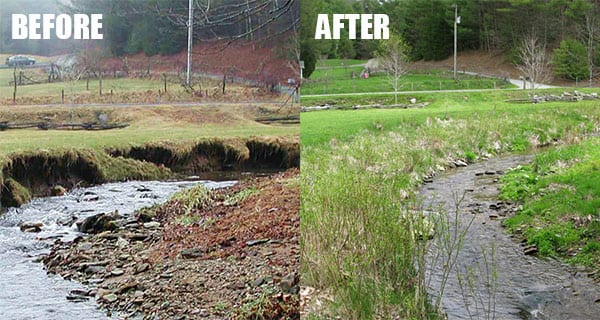Mowing your lawn to the water’s edge can cause all kinds of problems for the river. Streambanks need woody shrubs and trees along the bank – this is called the riparian zone. Without root systems, your soil is susceptible to erosion during rain events, and your property will wash away and pollute our waterways.
According to George Santucci, President of New River Conservancy, one of the most serious threats to the New River is the gradual destruction of riparian zones. “Unfortunately, one of the greatest threats to the river is the degradation of those buffers along the streams and rivers,” Santucci said. “Mud, by volume, is probably our largest pollutant in the river. I know mud doesn’t sound like a pollutant, but if you have gills, and you live on the bottom of the river, you’re not very excited about mud coming into the river.”
Some erosion is natural and necessary to river ecosystems, but vegetated buffers help support natural erosion and prevent excessive sedimentation. “There is some natural erosion that will happen over time, there’s absolutely no doubt. But substantial flood events or ice flows that scour the banks of the river will also happen,” said Santucci. “Heavily vegetated buffers are resilient against those forces.”
Establishing fully vegetated riparian buffers that include grasses, shrubs, and trees help support the river ecosystem, otherwise fish populations suffer. Fish depend on aquatic insects for food and aquatic insects are dependent on streamside vegetation for habitat.
Riparian zones also slow down runoff and filter pollutants before they ever reach the river. Ideally, rainwater would fall onto the ground, be slowed down by grasses and trees, and soak into the ground to replenish groundwater or enter the river slowly in a more natural way. However, without vegetated streambanks, polluted runoff flows straight into our streams and river at high velocities, further contributing to erosion of the banks.
“The more we denude the riverbanks, and the more we pave, the more we increase storm flow velocity to cause greater erosion than would happen naturally,” added Santucci.
If every landowner had a vegetated riparian buffer, less mud would make it to the river, insect populations would thrive and so would the fish that depend on them.
New River Conservancy is here to help! Since 1998, the New River Conservancy’s River Builder Program has planted and stabilized over 100 miles of the New River and its tributaries. Contact us to learn more about the River Builder Program and how you can protect your streambanks in the New River Watershed!
Chelsea Blount is the River Builder Coordinator for the New River Conservancy in Ashe County. Find out more at www.newriverconservancy.org.
